Porcelain Insulator News
by Jack H. Tod
Reprinted from "INSULATORS - Crown Jewels of the Wire", December 1973, page 12
Preferably direct porcelain news items and questions directly to Jack H. Tod,
3427 N. 47th Place, Phoenix, Ariz. 85018. All mail will be answered if reply
stamp is enclosed, and the most newsworthy items and questions of general
interest will be published as space permits.
Jim Allen, 850 S. Missouri, Springfield, Mo. 65806 (formerly of Phoenix)
recently found a new Illinois dry press style (usual "MACOMB" marking)
as illustrated here. This item is very similar to the U-244 except for the round
dome.
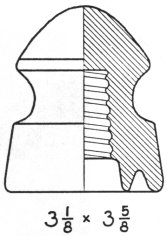
A study of the exact contours and also the character and location of the
MACOMB embossing leads to the conclusion that this is a completely different die
set than the U-244, and not merely the U-244 die set with a different crown
portion. We would like to hear from others having this item.
Dear Jack:
A friend of mine went to Spain on a recent trip, and I asked him if he saw any
insulators to bring me some. He brought me a number of one kind (shown here,
2-5/8" by 4"), and I'm sending one to you separately.
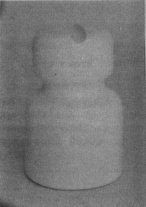
Not being a porcelain collector, I have no idea if this insulator is a good
collector item or not. Can you help as to collector value, etc.?
John Camp
Jackson, Miss.
- - - - - - - -
Dear John:
Many thanks for the specimen and which I'll add to the reference collection.
Whether it be stamps, coins or insulators, it in difficult for collectors to
get too enthused about foreign items if they cannot associate them with things
such an their manufacture, the country's history, economics, culture, etc. Thus
far nobody has traveled the world to research foreign insulators, their history
and their use, and I don't see anyone very enthusiastic about that either,
considering the magnanimity of the task.
Nevertheless, some people do collect insulators and other items without
specific knowledge of their origin or use, and I believe these would create some
trading activity for you with a sticker price in the $3 to $4 range.
My personal opinion is that the wire groove and tiewire methods on these
foreign styles is really stinko from the reliability standpoint, but they have
been that way for all these years, so I guess the foreign countries have learned
to live with these lousy desings. Some styles are much worse in this respect
than the item you have.
Jack
The incuse marking at the right has been reported by several collectors on
pin type cable styles, and these are reportedly in use on the Ontario Hyrdro
lines in Canada.

I believe this is a "customer marking" and that the
insulators are Canadian Porcelain Co. Can one of you fellows up that way let us
know what this marking is?
Dear Jack:
... Also enclosed is a drawing of a porcelain insulator that I have with no
information on. Can you help out on this one? It will be for sale or trade for
good glass only later on.
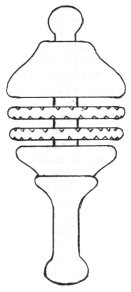
It is marked "U.S. PAT. 2,376,410" on one side and "KENT
PRODUCTS CO. Chicago, Ill." on the other. The two grooved disks and end
piece slide up and down on the central shaft. It's about 5" long overall.
James (Pete) Dennis
The Dalles, Oregon
- - - - - - - - -
Dear James:
We ran this item in the February 1970 issue of Crown Jewels (page 10), but
this is the 5th or 6th query we've had on it since then, so we will print the
answer again.
This is Patent 2,376,410, May 22, 1945, and it is a porcelain filter for a
drip coffee maker. Since these turn up so often in the junk box at our Good-will Workshop, I presume they must not have worked so well. Let me know how you
make out on your trade for good glass later on.
Jack
LET'S BE REALISTIC
(An editorial)
There is an ever-growing tendency on the part of some collectors to abuse the
terms "Rare" and "Scarce" in the description of insulators.
This is in evidence on trade lists, in ads and at insulator show bourse tables.
The terms will lose their descriptive value altogether if their indiscriminate
use is not abated.
A "Rare" collector item is one which is so infinitely desirable and
exists in such limited numbers that a specimen rarely is available for sale (at
any price).
A "Scarce" collector item is one where the supply is insufficient
to meet all potential demand but which can be located for purchase with
persistent efforts.
An "Uncommon" collector item is one where the supply is sufficient
to meet the demand but which has very limited distribution compared with other
similar items.
Some insulators listed as "Rare" are scarce at best, and some are
even outright common. It is unfortunate that the words "rare" and
"scarce" are so short and easy to write down. It seems collectors
really mean to say, "I didn't see one of these at the only two shows I've
ever been to, and the retired lineman down the street says he had never seen
one." All this is abbreviated and simplified on the trade list to
"RARE!!"
Even fairly experienced and knowledgeable collectors mislabel items as
"rare" or "scarce" just because they personally haven't seen
the item in their travels. Some porcelain styles are completely unknown in all
parts of the country except for one or several small areas where nearly all of
the insulators are of that style. There have been over 11,000 independent
electric utilities in this country, and every one had their own particular
habits concerning insulator styles. Just because we don't get into the area
where particular styles were used does not give cause to calling them rare.
It is also obvious some collectors try to "romance" certain
insulators and justify an unreasonably high price tag by labeling them as
"Rare!". This may unethically dupe some neophyte collectors, but it
makes the seller look foolish in the eyes of other collectors who know better.
After all, an insulator will either sell or it won't at any given price depending
on the competition and how badly the buyer wants it. If you have an insulator
which everyone else is selling for $3, it still isn't correct to put
"RARE" on your list to help justify your incorrect price of $20. Two
wrongs don't make a right.
There probably in no single person or even a group of individuals who have
been to enough insulator shows, seen enough collections and driven around all
the towns and cities in the country to actually determine if a given insulator
style is really common, scarce or rare. Would it not be better then to quit
confusing the issue by the unfounded rarity descriptions and let the insulator
availability speak for itself?
A similar but worse problem comes up when someone makes a statement such an
"One of only 5 known" or the like. Known to whom? With the exception
of several highly-publicized rare and highly desirable specimens, there isn't
anyone in the country qualified to make such rarity determination. The last time
such a statement accidentally got printed in Crown Jewels, there was a veritable
flood of mail received from other collectors who all had the same insulator.
There are a number of porcelain pin types of which I personally have seen or
heard of only one specimen, and it would be truthful to state "Only one
specimen known to me" - but, so what? Even in all my travels, I see only a
small percentage of the insulator collections and a very minute amount of the
area of this country in which insulators are used. The number I alone have seen
is meaningless. No company ever tooled up to make just a few of anything, and
items I have not seen myself may be common as dirt in some areas of the country.
Would it not be better then to refrain from using the statement "One of
only X known" unless you can qualify the statement with reference to some
exhaustive survey made to inquire of the other 10,000 collectors to make an
accurate inventory of the item?
Jack H. Tod
Dear Jack:
Noticed your two articles on nail knobs and special knobs in the May and June
Crown Jewels. I picked up an odd one I've sketched here (redrawn at right) which
is a two-piece type with a round top, no markings, glazed white. What is this?
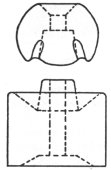
Edmund Circle
McCune, Kansas
- - - - - - - - -
Dear Ed:
This is called a "Paragon Knob" and was the creation of Paragon
Electric Co., Chicago, Ill. (factory in Manitowoc, Wis.). There use is obvious -
for surface wiring of twisted pairs such as phone leadins. These were made for
many years by Findlay and possibly other porcelain companies and may have been a
popular item judging from their widespread use.
Jack
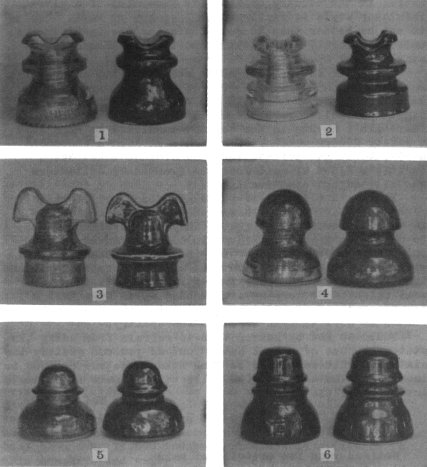
Here are some more interesting glass and porcelain look-alikes. The glass
insulator is on the left in each photo, and all photos here are not to the same
scale. More next mouth, space permitting.
1. Glass CD-251, "LYNCHBURG No. #1, aqua. Porcelain U-410, Pittsburg No.
43 (no name), brown.
2. Glass CD-220, "HEMINGRAY - 670", clear. Porcelain U-791
(Similar), "O-B", Ohio Brass No. 34848, brown.
3. Glass CD-257, "HEMINGRAY - 60", aqua. Porcelain U-395, Pittsburg
No. 34 (no name), brown.
4. Glass CD-285, "Edison" type (no name), aqua. Porcelain U-356A,
Pinco No. 249 (no name) brown.
5. Glass CD-287, "F. M. LOCKE VICTOR N.Y. / No. 15", aqua.
Porcelain U-344, G. P. Co. #131 (no name), brown.
6. Glass CD-152, "B", Brookfield No. 48, black glass. Porcelain
U-177, Locke No. 3188 (no name), brown.
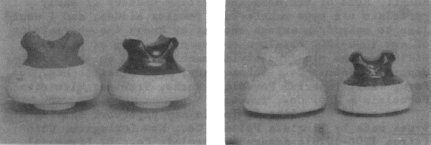
The pictures above illustrate the "magic of firing" in the
manufacture of porcelain. In each photo, the item on the left is the insulator
before it is fired and the one on the right is after firing. The 12% firing
shrinkage is quite noticeable.
The insulator in the left photo is the Pinco No. 12064, U-735. Note that the
radio treatment glaze here is an iron oxide overglaze application.
The insulator in the right photo is the I-T-E No. 5R, U-657. In this case,
the radio treatment glaze is applied first before the regular glaze. This glaze
permeates the regular glaze during firing and shows through as an ochre brown
color. Note also that this style is fired upright on the petticoat instead of
upside down an the Pinco example.
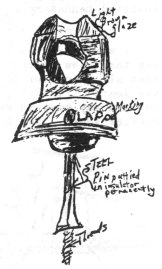
Dear Jack:
I have two porcelain insulators similar to the enclosed sketch. One is a
light brown Lapp, and the other is an unmarked dark brown one. I found both near
New Haven, Conn. Would like some information on these insulators as to price and
if they are rare.
Gary Arthur
West Haven, Conn.
- - - - - - - -
Dear Gary:
We ran very similar items in the October 1972 column, page 26.
These are known as "wireholders" usually used for short service spans
such as from alley poles to a house. Wireholders always have been and still are
a common item of manufacture, but these skirted designs are far less common than
the ordinary ones with flat bases. Your unmarked one might fetch $1 or so and
the Lapp one up to $3 from any Lapp specialists.
Jack
HELP!! Some of the most interesting history of early porcelain pin type
manufacture remains hidden, and I would like to hear from anyone who has or
known the whereabouts of any 1893-1900 catalogs or any other form of paperwork
picturing the pin type styles manufactured in that era by: General Electric Co.,
Schenectady; Peru Electric Mfg. Co., Peru, Ind.; Imperial Porcelain Works,
Trenton; Electrical Porcelain & Mfg. Co., Trenton.
We would also like to locate any paperwork showing pin types made by Virginia
Pottery Co., Now Lexington, Ohio (circa 1905-1913); Anderson Porcelain Co., E.
Liverpool, Ohio (1905-1913); Ceramic Specialties Co., East Liverpool, Ohio
(1932-1955); Ohio Porcelain Co., E. Liverpool, Ohio (ca. 1905-1913); Star
Porcelain Co., Trenton (1901-1907).
Please check the dark corners of the book cases at any very old utility
company offices in your area, and let's try to come up with something.
Jack
We've had several questions about inverted handstamp markings on porcelain -
their scarcity, desirability, etc. Normally the workmen took at least some care
to apply the markings upright, and the upside-down markings are quite uncommon.
Nevertheless, collectors usually prefer "good" marker impressions, and
this means neatly applied ones with the entire design readable and right side up
so you don't have to stand on your head to read it. Similarly, precancel stamp
collectors shun the inverted handstamp specimens like the plague!
I would like to thank all those who have written to say they have enjoyed the
porcelain column, and I want to wish all insulator fans a very Merry Christmas
and a Happy New Year. I'll let jolly U-982 below send you my greetings, and you
may have to work at it a bit to get the Christmas message there. Don't give up
though. It's there.
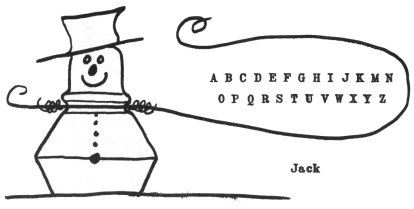
| 